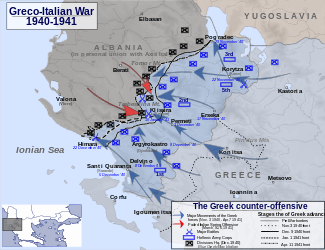Italian Spring Offensive
| ||||||||||||||||||||||||||||||
The Italian Spring Offensive, also known as Operazione Primavera (Operation Spring), was an offensive of the Greco-Italian War that lasted from 9 to 16 March 1941. The offensive was the last Italian attempt of the war to defeat the Greek forces, which had already advanced deep into Albanian territory.[1] The opening of the offensive was supervised by the Italian dictator Benito Mussolini but ended a week later in complete failure.[2][3][4]
Background
On 28 October 1940, Fascist Italy declared war upon Greece. The Italian 9th Army and 11th Army invaded north-west Greece from Albania. They were soon pushed back and the Greek army launched a counter-attack deep into Albanian territory.[5] In February 1941, intensive preparations to strengthen the Italian front line began. By the end of the month, the 15 Italian divisions fighting in Albania had been reinforced by an additional ten divisions. In order to raise the morale of the soldiers, Benito Mussolini ordered the units to be accompanied by the most aggressive fascist cadres and also by government ministers and high-ranking officials.[6]
Prelude
The operation was to be directed and observed by Mussolini, who arrived in Tirana on 2 March 1941; Italian radio announced that Mussolini lead the Italian attack.[6][7] Operazione Primavera, the spring offensive began on 9 March, under General Carlo Geloso and started with heavy bombardment of Greek positions by artillery and aircraft.[8][6] Eleven infantry divisions attacked with the support of the 131st Armoured Division Centauro.[9]
The attack was mainly directed against the 1st, 2nd, 5th, 11th, 15th and 17th divisions of the Greek army and was followed by repeated infantry assaults between the rivers Osum and Vjosë, an area dominated by Trebeshinë.[9] On 14 March, Italian General Ugo Cavallero, realizing that the attacks had failed, advised Mussolini to stop the offensive.[10] Fierce fighting occurred on height 731, which was assaulted by the Italians at least 18 times. The Greek forces maintained an active defence, which included counter-attacks and systematic exploitation of advantageous terrain. Decisive factors in the Greek success were that Greek artillery was not neutralized and the high morale of the Greek troops.[6]
Aftermath
After the Italian failure the Germans could no longer expect any appreciable support from their Italian allies when they marched against Greece, since Greek forces were only 16 kilometres (10 mi) away from the strategic port of Vlorë.[4][11] With the German intervention and the subsequent capitulation of Greece in April 1941, the sector around height "731" was proclaimed a holy area by the Italians and a monument was erected by them, due to the heavy casualties they suffered.[6]
Footnotes
- ↑ Zapantis 1982, pp. 428–584.
- ↑ Keegan & Mayer 1977, p. 600.
- ↑ Electris & Lindsay 2008, p. 187.
- 1 2 Zapantis 1987, p. 54.
- ↑ Dear & Foot 2001, p. 600.
- 1 2 3 4 5 Sakellariou 1997, pp. 395–398.
- ↑ Zōtos 1967, p. 39.
- ↑ Cruickshank 1976, p. 130.
- 1 2 Manchester 1994, p. 146.
- ↑ Chatzēpateras et al. 1995, p. 146.
- ↑ Gervasi 1975, p. 273.
References
- Chatzēpateras, Kōstas N.; Maria S., Phaphaliou; Leigh Fermor, Patrick (1995). Greece 1940–41 Eyewitnessed. Athens: Efstathiadis Group. ISBN 978-960-226-533-8.
- Cruickshank, Charles Greig (1976) [1975]. Greece, 1940–1941. London: Davis-Poynter. ISBN 0-70670-180-1.
- Dear, I.; Foot, M. R. D. (2001). The Oxford companion to World War II. London: Oxford University Press. ISBN 978-0-19-860446-4.
- Electris, Theodore; Lindsay, Helen (2008). Written on the Knee: A Diary from the Greek-Italian Front of WWII. Minneapolis, MN: Scarletta Press. ISBN 978-0-9824584-4-0.
- Gervasi, Frank (1975). Thunder over the Mediterranean. New York: McKay. ISBN 978-0-679-50508-2.
- Keegan, John; Mayer, Sydney L. (1977). The Rand McNally Encyclopedia of World War II. Chicago: Rand McNally. ISBN 0-52881-060-X.
- Manchester, Richard B. (1994). Incredible Facts: The Indispensable Collection of True Life Facts and Oddities. New York: BBS Publishing Corporation. ISBN 978-0-88365-708-9.
- Sakellariou, M. V. (1997). Epirus, 4000 years of Greek history and civilization. Ekdotike Athenon. ISBN 978-960-213-371-2.
- Zapantis, Andrew L. (1982). Greek-Soviet relations, 1917–1941. East European Monographs. New York: Columbia University Press. ISBN 978-0-88033-004-6.
- Zapantis, Andrew L. (1987). Hitler's Balkan Campaign and the Invasion of the USSR. Eastern European Monographs. New York: Columbia University Press. ISBN 978-0-88033-125-8.
- Zōtos, Stephanos (1967). Greece: The Struggle for Freedom. New York: Crowell. OCLC 712510.
